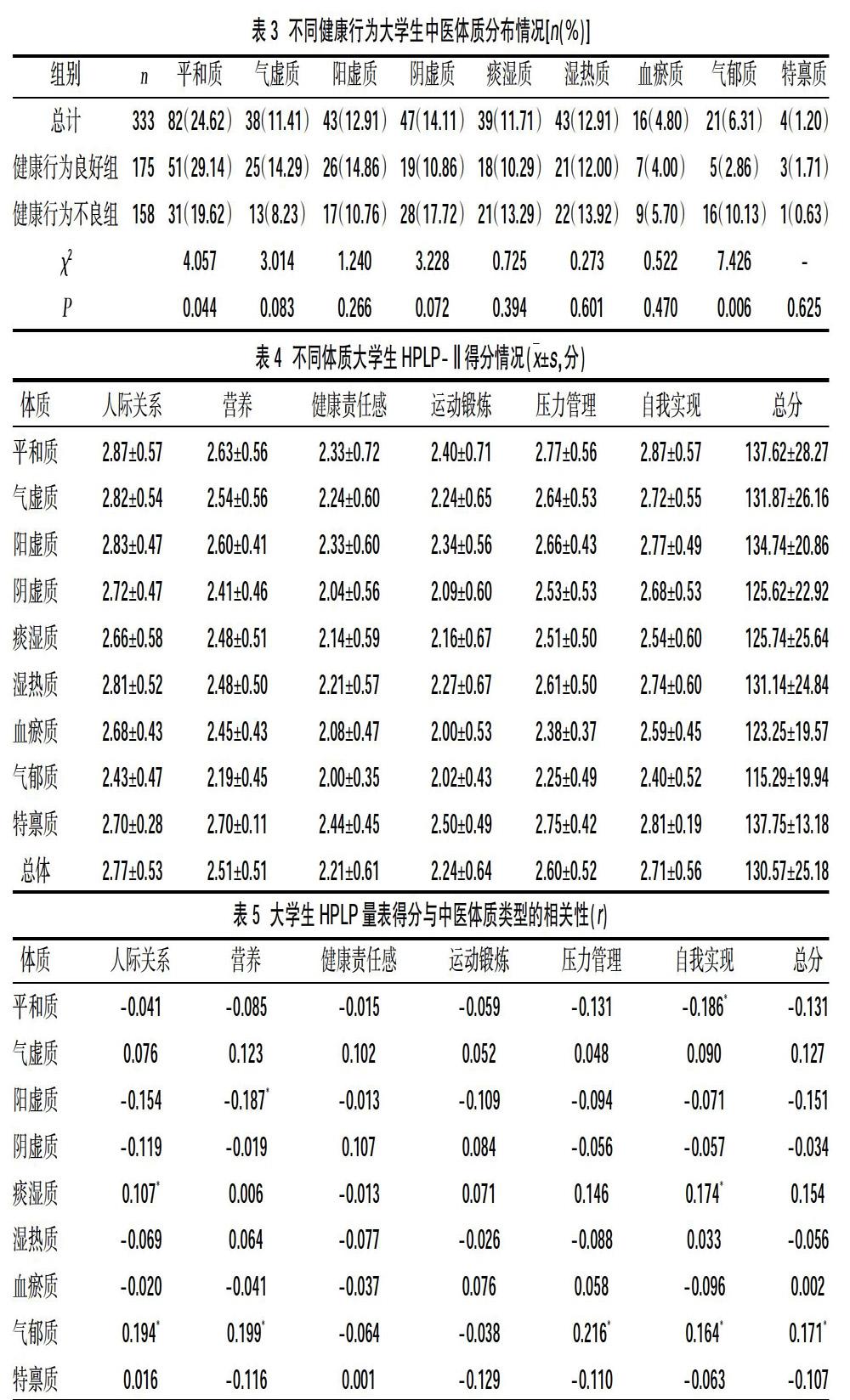高校大学生健康行为状况和中医体质的关系研究
2020-06-19陆涵钰徒文静彭文雯
陆涵钰 徒文静 彭文雯



摘要:目的 探究大学生健康行为状况和体质分布特点的关系,为大学生健康行为干预措施的制定提供参考。方法 于2019年3~9月采用便利抽样法抽取333名大学生,以标准化的中医体质量表及《中医9种体质类型判定标准》将大学生体质分为9种中医体质类型,运用健康促进生活方式-Ⅱ(HPLP-Ⅱ)量表采集大学生健康行为数据,根据HPLP单项均分将学生分健康行为良好组(HPLP单项均分≥2.5分,175名)和健康行为不良(HPLP单项均分<2.5分,158名)组,比较两组大学生健康行为状况及其与体质类型的相关性。结果 该校大学生HPLP-Ⅱ总分为(130.57±25.18)分,且健康行为良好组6个维度的单项得分与总分均高于健康行为不良组,差异有统计学意义(P<0.05)。大學生中医体质平和质最多,占24.62%,其余8种偏颇质共占75.38%。居前4位的偏颇体质类型为阴虚质(14.11%)、阳虚质(12.91%)、湿热质(12.91%)和痰湿质(11.71%);其中健康行为良好组平和质多于健康行为不良组,气郁质少于健康行为不良组,差异有统计学意义(P<0.05),且健康行为不良组出现最多的3种偏颇体质为阴虚质、湿热质、痰湿质。不同体质大学生HPLP-Ⅱ得分显示,特禀质得分最高,其次为平和质,气郁质得分最低;相关性分析显示,健康行为不良组气郁质的发生与人际关系、营养、压力管理、自我实现维度得分以及总分均呈正相关(P<0.05)。结论 该校大学生健康行为状况整体良好,健康行为状况与体质类型具有一定相关性。针对健康行为不良的学生,应鼓励其改善不良生活习惯,合理膳食,保持积极乐观的态度,改善偏颇体质,进而提高身体健康状况。
关键词:大学生;健康行为状况;中医体质;偏颇体质
Abstract:Objective To explore the relationship between the health behaviors of college students and their physical distribution characteristics, and to provide reference for the formulation of intervention measures for college students' health behaviors.Methods From March to September 2019, 333 college students were selected by the convenience sampling method, and the constitutions of college students were divided into 9 types of TCM constitutions based on standardized TCM physical fitness tables and "Judgment Standards for 9 Constitution Types of TCM". Health was used to promote lifestyle -Ⅱ (HPLP-Ⅱ) scale collects health behavior data of college students, and divides students into good health behavior groups (HPLP single average score ≥2.5 points, 175 students) and poor health behaviors (HPLP single average score <2.5 Points, 158 students) group, comparing the health behaviors of the two groups of college students and their correlation with physical types.Results The total score of HPLP-Ⅱ of the college students was (130.57±25.18), and the single dimension score and total score of 6 dimensions of the group with good health behavior were higher than those with poor health behavior, the difference was statistically significant (P<0.05). College students have the most physique of traditional Chinese medicine, accounting for 24.62%, and the remaining 8 types of biased qualities account for 75.38%. The top four biased constitution types are Yin deficiency (14.11%), Yang deficiency (12.91%), damp heat quality (12.91%), and phlegm dampness (11.71%); among them, the group with good health behavior has more peace and health than health In the poor behavior group, the qi depression quality was less than that in the healthy behavior group, the difference was statistically significant (P<0.05), and the three most biased constitutions in the healthy behavior group were yin deficiency, damp heat, and phlegm and dampness. HPLP-Ⅱ scores of college students with different constitutions showed the highest scores for specialty traits, followed by peace quality and lowest score for depression. Correlation analysis showed that the occurrence of depression in the group with poor health behavior was related to interpersonal relationships, nutrition, stress management, and self. The achievement dimension score and the total score were positively correlated (P<0.05).Conclusion The health behaviors of the college students are generally good, and there is a certain correlation between health behaviors and physical types. For students with poor health behaviors, they should be encouraged to improve their unhealthy living habits, eat a reasonable diet, maintain a positive and optimistic attitude, improve their biased physique, and then improve their physical health.
